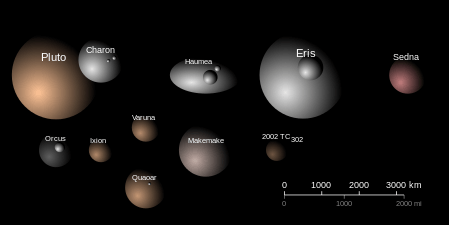(84522) 2002 TC302
| Discovery[1] | |
|---|---|
| Discovered by |
M. E. Brown, C. A. Trujillo, D. L. Rabinowitz(?) |
| Discovery date | 9 October 2002 |
| Designations | |
| MPC designation | (84522) 2002 TC302 |
| 2:5 resonance[3][4] | |
| Orbital characteristics[5] | |
| Epoch 13 January 2016 (JD 2457400.5) | |
| Uncertainty parameter 3 | |
| Observation arc | 5574 days (15.26 yr) |
| Aphelion | 71.552 AU (10.7040 Tm) |
| Perihelion | 38.979 AU (5.8312 Tm) |
| 55.265 AU (8.2675 Tm) | |
| Eccentricity | 0.29469 |
| 410.86 yr (150065 d) | |
Average orbital speed | 3.93 km/s |
| 322.056° | |
| 0° 0m 8.636s / day | |
| Inclination | 35.107° |
| 23.902° | |
| 87.142° | |
| Earth MOID | 38.1784 AU (5.71141 Tm) |
| Jupiter MOID | 34.8125 AU (5.20788 Tm) |
| Physical characteristics | |
| Dimensions |
584.1+105.6 −88.0[6] |
| 5.41 h (0.225 d)[7] | |
|
0.115+0.047 −0.033[6] | |
|
(red) B−V=1.03; V−R=0.67[8] | |
| 20.5 (opposition)[9] | |
| 3.8[5] | |
|
| |
(84522) 2002 TC302 is a red 2:5 resonant[3] trans-Neptunian object (TNO) discovered on October 9, 2002 by Mike Brown's team at the Palomar Observatory.[1]
Physical characteristics
(84522) 2002 TC302 has an absolute magnitude (H) of 3.78.[5] It has an estimated diameter of 584.1+105.6
−88.0 km.[6] Using the Spitzer Space Telescope, it was previously estimated to have a diameter of 1145+337
−325 km,[10] which would have made it one of the largest possible dwarf planets. This overestimation was due to insufficient motion to allow for a good sky subtraction and because it was very close to a brighter background object.[6] Brown noted that the Spitzer measurement involved a very large potential error and that the object would likely be smaller, making its chances of it being a dwarf planet "likely" rather than "near certainty", in his opinion.[11]
It was predicted that on 30 November 2013, (84522) 2002 TC302 might occult a star for slightly less than a minute.[12] However, the possibility to observe this occultation was judged as small. The precise duration that a Solar System object occults a star provides a precise way to determine its diameter, if observed from multiple locations.
The red spectra suggests that (84522) 2002 TC302 has very little fresh ice on its surface.[10]

Its rotational period is most likely 5.41 h, and it has a light-curve amplitude of 0.04±0.01 mag.[7]
Orbit
(84522) 2002 TC302 will come to perihelion in 2058.[5] Its perihelion (minimum distance from the Sun) of 39.1 AU[5] is about the same as Pluto's semi-major axis (average distance from the Sun). It is classified as a scattered disc object.[2][3]
Given the long orbit that TNOs have around the Sun, (84522) 2002 TC302 comes to opposition in late October of each year at an apparent magnitude of 20.5.[9]
Resonance
Both the Minor Planet Center (MPC) and the Deep Ecliptic Survey (DES) show this probable dwarf planet to be in a 2:5 resonance with Neptune.[3][4] Due to the resonance, it completes two orbits for every five orbits of Neptune.
As of 2009, it is the largest likely dwarf planet that is known to be in a non-plutino resonance with Neptune. Plutinos are objects in 2:3 mean-motion resonance with Neptune. For every two orbits that a plutino makes, Neptune makes three.
 A still frame showing the motion of (84522) 2002 TC302 relative to Neptune being held stationary |
 The 2:5 resonance motion of (84522) 2002 TC302 (red) and the 2:3 resonance of Pluto (grey). Neptune is held stationary. |
Precovery
It has been observed 76 times over nine years.[5]
See also
References
- 1 2 Marsden, Brian G. (2002-11-07). "MPEC 2002-V26 : 2002 TC302". IAU Minor Planet Center. Harvard-Smithsonian Center for Astrophysics. Retrieved 2010-01-06.
- 1 2 "List Of Centaurs and Scattered-Disk Objects". Minor Planet Center. Retrieved 2008-09-19.
- 1 2 3 4 Marc W. Buie (2007-09-16). "Orbit Fit and Astrometric record for 84522". SwRI (Space Science Department). Retrieved 2008-09-19.
- 1 2 "MPEC 2009-C70 :Distant Minor Planets (2009 FEB. 28.0 TT)". Minor Planet Center. 2009-02-10. Retrieved 2009-03-05.
- 1 2 3 4 5 6 "JPL Small-Body Database Browser: 84522 (2002 TC302)" (last observation:2009-10-25). Retrieved 7 April 2016.
- 1 2 3 4 S. Fornasier, E. Lellouch, T. Müller, P. Santos-Sanz, P. Panuzzo, C. Kiss, T. Lim, M. Mommert, D. Bockelée-Morvan, E. Vilenius, J. Stansberry, G.P. Tozzi, S. Mottola, A. Delsanti, J. Crovisier, R. Duffard, F. Henry, P. Lacerda, A. Barucci, & A. Gicquel (2013). TNOs are Cool: A survey of the trans-Neptunian region. VIII. Combined Herschel PACS and SPIRE observations of 9 bright targets at 70–500 µm.
- 1 2 Short-term variability of 10 trans-Neptunian objects
- ↑ Tegler, Stephen C. (2006-01-26). "Kuiper Belt Object Magnitudes and Surface Colors". Retrieved 2006-11-05.
- 1 2 "(84522) 2002 TC302". Minor Planet Center. 2010-07-23. Retrieved 2010-10-24.
- 1 2 John Stansberry; Will Grundy; Mike Brown; Dale Cruikshank; John Spencer; David Trilling; et al. (2007). "Physical Properties of Kuiper Belt and Centaur Objects: Constraints from Spitzer Space Telescope". arXiv:astro-ph/0702538
 [astro-ph].
[astro-ph]. - ↑ Michael E. Brown. "How many dwarf planets are there in the outer solar system? (updates daily)". California Institute of Technology. Retrieved 31 August 2016.
- ↑ Stevge Preston's Asteroid Occultation Updates item; accessed 22 February 2013
External links
| Wikimedia Commons has media related to (84522) 2002 TC302. |
- Orbital simulation from JPL (Java) / Horizons Ephemeris
- TNO 2002 TC302 (Image of the Month, January 2003)
- (84522) 2002 TC302 at the JPL Small-Body Database
_(cropped).jpg)
